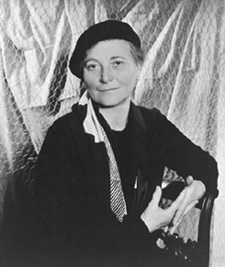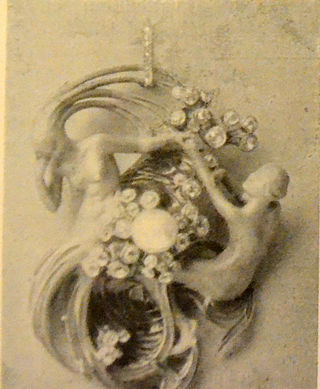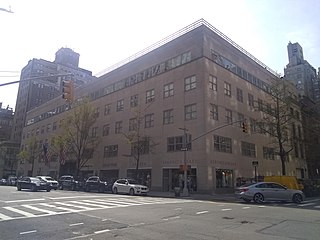
Christie's is a British auction house founded in 1766 by James Christie. Its main premises are on King Street, St James's in London, and it has additional salerooms in New York, Paris, Hong Kong, Milan, Amsterdam, Geneva, Shanghai, and Dubai. It is owned by Groupe Artémis, the holding company of François Pinault. In 2022 Christie's sold $8.4 billion in art and luxury goods, an all-time high for any auction house. In 2017, the Salvator Mundi was sold at Christie's in New York for $450 million, the highest price ever paid for a single painting.

Sotheby's is a British-founded American multinational corporation with headquarters in New York City. It is one of the world's largest brokers of fine and decorative art, jewellery, and collectibles. It has 80 locations in 40 countries, and maintains a significant presence in the UK.

Mary Quinn Sullivan, born Mary Josephine Quinn, was a pioneering collector of European and American modern and contemporary art and gallerist, and a founding trustee of the Museum of Modern Art, which opened in rented space in New York City in November 1929. She also led a small group of Indianapolis, Indiana, art patrons who called themselves the Gamboliers and between 1928 and 1934 selected artworks of for the group that brought some of the first modern and contemporary works to the collections of the John Herron Art Institute, which later became the Indianapolis Museum of Art. Mary and Cornelius J. Sullivan, her husband, amassed a significant private collection of art during the 1920s and 1930s that included Modigliani's Sculptured Head of a Woman, Paul Cézanne's Madame Cézanne, Georges Rouault's Crucifixion, and a Hepplewhite desk that once belonged to Edgar Degas, as well as works by Pierre-Auguste Renoir, Paul Gauguin, Henri de Toulouse-Lautrec, Vincent van Gogh, Pierre Bonnard, Pablo Picasso, and others.

Hagop Kevorkian was an Armenian-American archeologist, connoisseur of art, and collector. Originally from Kayseri, and a graduate of the American Robert College in Istanbul, he settled in New York City in the late 19th century, and was responsible for drawing greater attention to Near Eastern and Islamic artifacts in the United States.

Cortlandt Field Bishop was an American pioneer aviator, balloonist, autoist, book collector, and traveler.

In auctions, the buyer's premium is a charge in addition to the hammer price of an auction item, or lot. The winning bidder is required to pay both the hammer price and the percentage of that price called for by the buyer's premium. It is charged by the auctioneer in addition to the commission which has always been charged by auction houses to sellers. All of the buyer's premium is retained by the auction house and is not shared with the item's seller.
The Japanese Art Society of America (JASA) promotes the study and appreciation of Japanese art. Founded in 1973 as the Ukiyo-e Society of America by collectors of Japanese prints, the Society's mission has expanded to include related fields of Japanese art.
Frank Richard Perls was a German-born American art dealer who was best known for uncovering a series of fraudulent art works. As an interpreter with the United States Third Army, Perls worked together with Army intelligence officer Martin Dannenberg in April 1945 in the discovery of a copy of the 1935 Nuremberg Laws signed by Adolf Hitler.

Edith Halpert or Edith Gregor Halpert was a pioneering New York City dealer of American modern art and American folk art. She brought recognition and market success to many avant-garde American artists. Her establishment, the Downtown Gallery, was the first commercial art space in Greenwich Village. When it was founded in 1926, it was the only New York gallery dedicated exclusively to contemporary American art by living artists. Over her forty-year career, Halpert showcased such modern art luminaries as Elie Nadelman, Max Weber, Marguerite and William Zorach, Stuart Davis, Peggy Bacon, Charles Sheeler, Marsden Hartley, Yasuo Kuniyoshi, Ben Shahn, Jack Levine, William Steig, Jacob Lawrence, Walter Meigs, Arthur Dove, John Marin, Georgia O'Keeffe, and many others. Halpert later expanded her business to include American folk art, and certain nineteenth-century American painters, including Raphaelle Peale, William Michael Harnett, and John Frederick Peto, whom she considered to be precursors to American modernism.

Henri Vever (1854–1942) was one of the most preeminent European jewelers of the early 20th century, operating the family business, Maison Vever, started by his grandfather. Henri was also a collector of a broad range of fine art, including prints, paintings, and books of both European and Asian origin. By the 1880s, Vever became one of the earliest Europeans to formally collect Japanese ukiyo-e woodblock prints, purchasing extensively from dealers such as Hayashi Tadamasa. He was a member of Les Amis de l'Art Japonais, a group of Japanese art enthusiasts including Claude Monet, that met regularly to discuss Japanese prints and other works over dinner.

The American Art Association was an art gallery and auction house with sales galleries, established in 1883.
John L. Marion is an American auctioneer and philanthropist. He served as the Chairman of Sotheby's from 1975 to 1994.

Thomas Ellis Kirby (1846–1924) was an auctioneer at American Art Galleries. He was known as the "grand old man of the auction room".

La Gommeuse[la ɡɔmøz] is a 1901 oil-on-canvas painting by the Spanish artist Pablo Picasso. It dates from his Blue Period and is noted for its caricature of Picasso's friend Pere Mañach painted on the reverse. Gommeuse was sexually charged slang of the time for café-concert singers and their songs. It was offered for sale ex the William I. Koch collection at a Sotheby's, New York, auction on 5 November 2015. The painting realized $67.5 million at the sale, a record for a Blue Period Picasso, placing the painting among the most expensive ever sold.
Peregrine Michael Hungerford Pollen was an English auctioneer who headed Parke-Bernet in the 1960s after it was purchased by Sotheby's. He was known for expanding the auction house in North America, and bringing a dramatic flair to auctions.

980 Madison Avenue is a building located at Madison Avenue and East 76th Street on the Upper East Side of Manhattan in New York City. It served as the headquarters of Parke-Bernet Galleries from its opening on November 10, 1949 to its sale in 1987. In 2006, TheNew York Times wrote that the building had functioned as "the Grand Central Terminal of the art world." The building is part of the Upper East Side Historic District.

After the Bath is a painting from 1910 by the French painter Pierre-Auguste Renoir representing his late work period (1892–1919). The painting is now in the Barnes Foundation in Philadelphia.
Anderson Galleries began as an auctioner of books, prints, and occassionally art called Anderson Auction Company. It was founded by John Anderson, Jr. in 1900 and later renamed Anderson Galleries. In 1917, the gallery began selling antiques and art at their new location on Park Avenue and 59th Street. In the 1920s, Mitchell Kennerley, who ran the business, sold the works of Marsden Hartley, photographs of Alfred Stieglitz, and the works of Georgia O'Keeffe, John Marin, and Charles Demuth.













